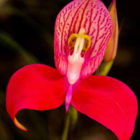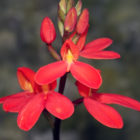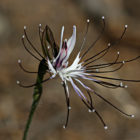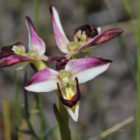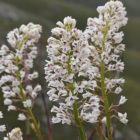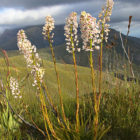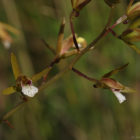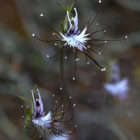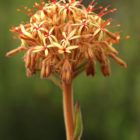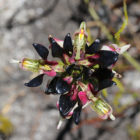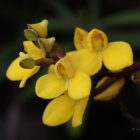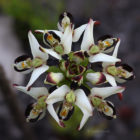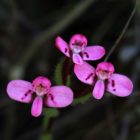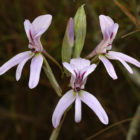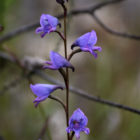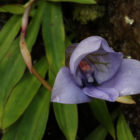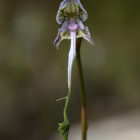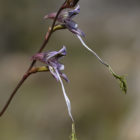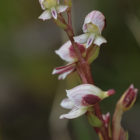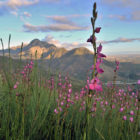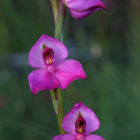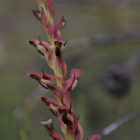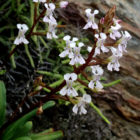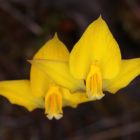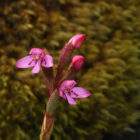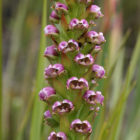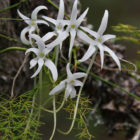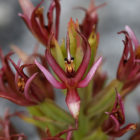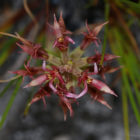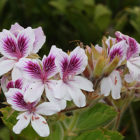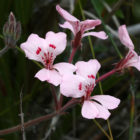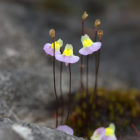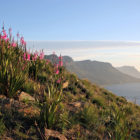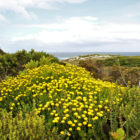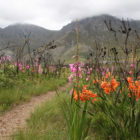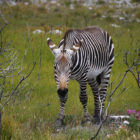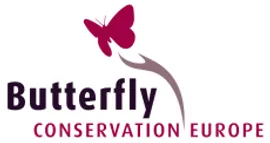Dates & Prices |
BOOK NOW |
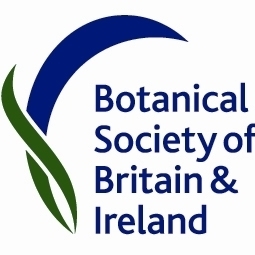 Dates: 24th Nov – 6th Dec 2025
Dates: 24th Nov – 6th Dec 2025
Price: £3,995 places available
Single Room Supplement: £400
Deposit: £400 per person
Price Includes: All meals, accommodation with private facilities, ground transport, services of the guides & holiday report
Not Included: Flights, travel insurance, drinks and any other personal items
Conservation Donation: Botanical Society of Britain & Ireland (BSBI)
Leaders: Frank Gaude (plus a second guide for a larger group)
Languages: Guiding in English plus German
Group Size: Minimum of 4 and a maximum of 9 guests plus 1-2 leaders.
Holiday Highlights
- Explore the Cape Floral Kingdom, home to over 9,000 plant species!
- High diversity of South African orchids
- Unique Fynbos Flora of the winter-rainfall areas of SA, including the national flower, the King Protea (Protea cynaroides)
- Focus on the amazing orchids including the extraordinary variety found from the Disa genus
- Showy and diverse landscape of the Cape Fold Mountains and the Garden Route
- Cape Peninsula Tour including Cape of Good Hope and African Penguin colony
- Visit to Table Mountain, one of the new 7 wonders of nature
- Spectacular Mountain Passes (Montagu and Swartberg Passes)
- Visit a number of locations to search for orchids, including Table Mountain National Park, Cape of Good Hope, Cape Point, Garden Route & Klein Karoo
- A great time to escape winter in Northern Europe and just before the Christmas season too!
- Please be aware that this is a reasonably intensive tour, aiming to see as many of the iconic orchid species as possible, and therefore some long drives are necessary, including some on unmade roads
The Cape Floral Kingdom, one of the six recognised floral kingdoms of the world, is an area of extraordinarily high diversity and endemism, and is home to over 9,000 vascular plant species, This bio-diversity is associated with fynbos, a Mediterranean type biome of woodlands and scrub. Central to this is fire which clears areas every now and then, stimulating the flowering of orchids and bulbs. Home to the fynbos is a set of extraordinary orchids belonging to the genus Disa. For terrestrial orchids members of the Disa genus rival epiphytic orchids in variety and colour. The genus comprises about 180 species indigenous to tropical and southern Africa, with a few more in the Arabian Peninsula, Madagascar and Réunion. A large number occur in a small area in the Western Cape of South Africa’; some are common whilst others are rare and their appearance depends on fire. Their habitat can be mountain streams or bare rocky terrain Disa exhibit similarities with the genus Ophrys as regard to their pollination mechanism. Each species of Disa usually has a single species as pollinator. They employ a large range of pollinating insects such as butterflies, carpenter bees whilst night-scented flowers are pollinated by moths. Some Disa species are pollinated by sunbirds and have pollinaria that stick to the feet of the sunbirds when they perch on the inflorescence. Our aim during this holiday is to see the commoner species such as Disa cornuta, D. cylindrica and D. tenuifolia, but also look for the rarer and fire-dependent species such as Acrolophia lunata, Disa atricapilla and bivalvata, and Pachites bodkinii amongst many others. We hope to see some early flowering specimen of the iconic Red Disa (Disa uniflora), too. Acrolophia is another genus of the orchids we shall look for, species such as Acrophia capensis, Acrophia cochlearis and other members of the genus in coastal sands and fynbos. Since many species depend on fire for flowering and this may vary from year to year, we shall keep the itinerary somewhat flexible to visit areas that have recently burned. Some of these areas we may not have visited during the research undertaken for the trip. A selection of species reliant on fire are members of the Ceratantha genus such as Ceratantha globosa and Ceratandra harveyana and members of the Holothrix genus which we shall also look for. We shall also search for the extraordinary Bartholina etheliea and members of the Corycium genus such as Corycium carnosum (now Evotella carnosa), pollinated by oil-collecting bees and Orthochilus, Pterygonium and Satyrium species We shall visit some of the representative habitats such as Fynbos and Afrotemperate Forest, and protected areas such as Table Mountain National Park, Garden Route National Park and Kogelberg Nature Reserve. Table Mountain National Park forms part of the Cape Floristic Region and as such supports a high diversity of flora. The Kogelberg Nature Reserve is located in the Kogelberg Mountains, on the eastern edge of Cape Town and protects a significant portion of Kogelberg Sandstone Fynbos. The Kogelberg mountains have a floral diversity per unit area that is greater than anywhere else in the world. On our travels we shall see examples of other plant families such as Protea, Erica and many bulbous plants. Weather: Akin to summer in a Mediterranean climate; temperatures possibly between 15 degrees at night and well into the 30s during the day. Some precipitation is possible and light rain gear might be a good idea. Passport requirements: Please ensure you have at least 2 – 3 blank pages in your passport as you will be denied entry to South Africa unless you have 1 blank page. UK passport holders do not need a visa to enter South Africa but if you are traveling on the passport of another country then please check the requirements. Health and fitness: Regular hikers /walkers won’t find this tour demanding, but some level of basic fitness is required for some of the walks. We will allow for plenty of time for steep sections and we will only do fairly short walks of up to 6km, but we will spend lots of time in the open where shade may not always be available and temperatures may reach 30+ degrees. Please be aware that this is a reasonably intensive tour, aiming to see as many of the iconic orchid species as possible, and therefore some long drives are necessary, including some on unmade roads. Travel: For the duration of the tour we will use a comfortable and air conditioned 14-seater minibus with a separate locked luggage trailer, meaning ample space for all guests. Languages: The guides are native and/or fluent speakers in English and German. This is a fantastic tour – we recommend booking early to avoid disappointment!




Day 0 (25th November): Overnight flight from London for UK based guests.
Day 1 (26th November):
Day 1: Transfer from Cape Town Airport to our accommodation in Cape Town
Half-Day excursion, should the remaining time suffice.
Day 2: Cape Peninsula Tour
This day consists mostly of the classic Peninsula Tour, which includes a visit to the African Penguin colony at Boulders Beach, Cape Point Nature Reserve and Silvermine Nature Reserve, all part of the Greater Table Mountain National Park.
We won’t entirely ignore the classic sights on this outing, such as the Cape of Good Hope, but we aim to chase down some orchid species on this day as well.
We start the day with a ca 30 minute drive to Silvermine Nature Reserve where we will go on a walk to attempt to find three Acrolophia species, Acrolophia capensis, Acrolophia lamellata and the intriguing ‘Up-side-down’ Acrolophia, A.bolusii. We will not only look out for orchids, but also the other fynbos plants of the area, such as the ‘Mountain Dahlia’ (Liparia splendens). Not a Dahlia at all, but belonging to the legume family (Fabaceae), the clusters of flowers of this shrub superficially resemble an orange Dahlia flower.
We will continue our day-tour to Boulders Beach in order to see the African Penguins (Spheniscus demersus), who have made this beach their home in the early 1980s and since have successfully occupied this desirable spot on the East Coast of the Cape Peninsula.
From the Penguins we drive to Cape Point Nature Reserve where we will attempt to find the beautiful Disa purpurascens amongst other interesting plants and animals like Cape Snow or White Everlasting (Syncarpha vestita), Chacma Baboons (Papio ursinus) and the Bontebok (Damaliscus pygargus pygargus).
We will make time for the obligatory photograph at the Cape of Good Hope before we return to Cape Town (about 1 ½ hours from the Cape of Good Hope).
Day 3: Cape Town – Greyton
We leave Cape Town and head East on the N2 highway, about 170 km/2 hours until we reach the small town of Greyton, where we will spend the next two nights.
Greyton is a pretty, historic town in South Africa’s Overberg region with many well-preserved Cape-Dutch and Victorian buildings, almost surrounded by the Greyton Nature Reserve.
Almost the entire Fynbos vegetation of this nature reserve burnt in a large veld fire in December 2019. Many orchids in the Western Cape are fire-dependent and only flower in the first few seasons after a fire. We hope to still see some of those species on a walk in the Greyton Nature Reserve where we will spend most of the afternoon.
Possible orchid species: Acrolophia capensis, Ceratandra atrata, Disa atricapilla, D. bivalvata, D. racemosa
Other interesting species: Many Pelargonium species, bulbous plants of the family Iridaceae.
Possible bird species include the Cape Rock Jumper (Chaetops frenatus).
We will stay at a hotel in Greyton.
Day 4: Excursion from Greyton into the Overberg region
We keep the exact content of this day’s excursion open, so that depending on previous rainfall and fires we may alter our route to best suit our interest. We may very likely visit the Sandberg Fynbos Reserve close to the town of Napier, where the very beautiful Disa venusta and also Disa filicornis occur.
The little reserve is also known for the occurrence of the Hottentot Buttonquail (Turnix hottentotus) even though they are rarely seen.
The huge open spaces of harvested wheat, maize and Canola fields, so very characteristic of the Overberg nowadays, are of course deserts of biodiversity but do offer easy sightings of the Blue Crane (Anthropoides paradiseus).
We will stay at a hotel in Greyton.
Day 5: Greyton to George
Today’s long drive of ca 340km/ 4 hours takes us to George, one of the administrative centres of the area known as the ‘Garden Route’, where we will spend the next three nights.
The Garden Route has not been named after its many gardens, as one may expect, but rather from its opulent and varied vegetation, enabled by the high rainfall experienced in this area.
The greater George area straddles several habitat types, including littoral veld, Afromontane Forest, Mountain Fynbos and even a bit of succulent Karoo, so different orchid species with very different environmental requirements occur within reach.
We may break up the long drive with photo stops at suitable locations.
Day 6: Outeniqua Mountains
We will spend the entire day exploring the nearby Mountain Fynbos of the surrounding Outeniqua Mountains from one of the historic and scenic pass roads of the Cape Fold Mountains, the Montagu Pass.
We hope to find the following orchids: Bartholina etheliae, Brachycorythis macowaniana, Ceratandra globosa, C. grandiflora, Disa cylindrica, D. hians, D. reticulata, D. sagittalis, and Habenaria lithophila.
Of course we won’t restrict ourselves to the local orchids, but will also be on the look-out for other plants of interest, such as the famous King Protea (Protea cynaroides), the national flower of South Africa.
Day 7: Coastal garden Route
From our accommodation we will drive towards the southern, green side of the Outeniqua Mountains to the town of Wilderness, where we will visit a section of the Garden Route National Park, and embark on a hike through dense Afro-temperate forest growing on the mountain slopes and along river courses.
We will hopefully see, but definitely hear the well-known Knysna Touraco (Touraco corythaix) and possibly some Kingfisher species.
The orchids in this forest are mainly of epiphytic (tree-dwelling) adaptation, such as Mystacidium capense, Cyrtorchis arcuata and Tridactyle bicaudata bicaudata. With some luck we may find a flowering specimen of Bonatea speciosa.
Apart from the orchids we expect to find beautiful specimen of the ‘Cape Chestnut’, Calodendrum capense and species of Plectranthus and Streptocarpus.
We will further explore forest and littoral areas in search for other species such as the tiny Disperis lindleyana and the large and showy Eulophia speciosa.
Day 8: George – Swartberg Pass – Barrydale
A longer stretch of travelling will be covered on this day (ca.300 km / 4 ½ hours). Many observations will happen on route to our next overnight stop, with spectacular landscapes and unusual species.
We will drive north of the Outeniqua Mountains, passing the town Oudtshoorn, the economic centre of the ‘Klein Karoo’, the area between the Outeniqua and the Swartberg Mountains, a species-rich, semi-arid area of Succulent Karoo. Inevitably we will see many ostriches in captivity, since Oudtshoorn is the centre of Ostrich breeding in South Africa. From Oudtshoorn we will drive up the well-known Swartberg Pass, probably the most famous pass road in South Africa, known for both its scenic splendour as well as its adventurous, untarred road and the main botanical highlight of the day.
We will frequently stop on this road to sample the local vegetation, which will vary considerably from what we saw thus far, as this is a very dry and windswept area, experiencing frost and snow in winter.
Although we will be on the look-out for any flowering plants in this area, of course we are going to focus on orchids, especially the unusual Disa multifida with its extraordinarily long lip. Other orchid species that we may discover are Acrolophia capensis, Disa filicornis, Disa bolusiana, Holothrix brevipetala and Satyrium eurycalcaratum.
There will be a multitude of other plant species from the family of the Proteaceae, Ericaceae and several species of Pelargonium, some of which are endemic to this area.
With a bit of luck, we may see the agile Klipspringers (Oreotragus oreotragus), a small species of antelope well adapted to living in mountainous terrain, or the local troop of Baboons.
From the Swartberg Pass it will take us about 2 hours to reach the small town of Barrydale in the Klein Karoo, where we will spend the next two nights.
Day 9: Barrydale
After breakfast we will visit horticulturist Hildgard Crous in her nursery where she will give us a tour of her collection of South African orchid species and hybrids. Hildegard Crous is an authority on orchid cultivation and has curated the Kirstenbosch collection in Cape Town before she started her own nursery in Barrydale.
After the nursery talk Hildegard will take us on an easy walk to show us locally occuring orchids in habitat.
Day 10: Barrydale – Cape Town
Today we return to Cape Town, which will take us about 4 hours (250 km) and where we will spend the last three nights.
We will stop at good habitats to break up the journey.
Day 11: Table Mountain Plateau Walk
Most of this day we will spend on the iconic Table Mountain, one of the places with the highest biodiversity in South Africa, despite being surrounded by a metropole of ca 5 million inhabitants.
We will make use of the Cable Car to reach the plateau at ca. 1070 masl and from there start our walk on top of Table Mountain and the area known as the ‘Back Table’.
No particular mountaineering skills are required, but it will be a long day spent on the mountain and we will walk into and out of gorges on the mountain, so some elevation will be involved which requires some fitness and good hiking shoes.
Especially south-facing rockfaces will get our attention, where moisture gathers as mist coming from the sea and providing a lot more precipitation than on the north-facing slopes. The most spectacular orchid species that we will search for today is the ‘Drip Disa’ (Disa longicornu). In its company we should find some other Disa species as well, such as Disa cornuta, D.glandulosa, D. harveyana, D. ocellata, D.tenuifolia and D. vaginata and also Evotella carnosa.
Many other plant species will be in flower, such as members of the Proteaceae, Ericaceae, Gladioli, Crassula and many more.
We may see interesting bird species such as Ground Woodpeckers (Geocolaptes olivaceus), Cape Sugar Birds (Promerops cafer) and Orange-Breasted Sunbirds (Anthobathes violacea).
Many red-flowering plants will attract the Table Mountain beauty (Aeropetes tulbaghia), but they are in seemingly constant movement and hard to photograph.
The re-introduced Klipsringers (Oreotragus oreotragus) are making a comeback on Table Mountain, so we will have to keep an eye out for them, too.
Interesting, frequently seen reptiles include the Black Girdled Lizard (Cordylus niger), Southern Rock Agama (Agama atra) and the Cape Crag Lizard (Pseudocordylus microlepidotus microlepidotus).
Day 12: Kogelberg Nature Reserve, False Bay
Today we will visit Kogelberg Nature Reserve, one of the most species-rich areas of the Western Cape. Whilst a visit of this reserve may not yield too many orchid species at this time of year, we can still not ignore it due to its general biodiversity and who knows, maybe we stumble upon an orchid species that we did not expect.
The easiest hike in the reserve is the Palmiet River Hike, following the course of the river. There is no obvious elevation involved, but it is still a rough, uneven path that requires some concentration on the terrain underfoot.
We will see Pelargonium species, Roella sp. of the Bellflower family, many members of the Iridaceae and possibly the first emerging Agapanthus africanus and Nivenia sp.
This is also a hotspot for Damsel- and Dragonflies (Odonata). Smaller animals include Cape River Frog (Amietia fuscigula) and Clicking Stream Frog (Strongylopus grayii) and we may hear and see the local Baboon troop.
Another possible stop will be the Harold Porter Botanical Garden in Betty’s Bay, where we can have a general look at this small garden embedded in beautiful landscape that is frequently visited by local bird species and other animals such as Baboons, Tortoises and other reptiles.
On our way back, in Betty’s Bay, we will also keep an eye out for the rare Satyrium hallackii, a conspicuous pink flowering Satyre Orchid with inflorescences up to 50 cm high.
We continue our journey back to Cape Town on Clarence Drive, one of the most spectacular coastal drives in South Africa.
Day 13 (6th December)
The end of our tour and transfer to Cape Town International Airport.
New holiday – testimonials will appear next year


